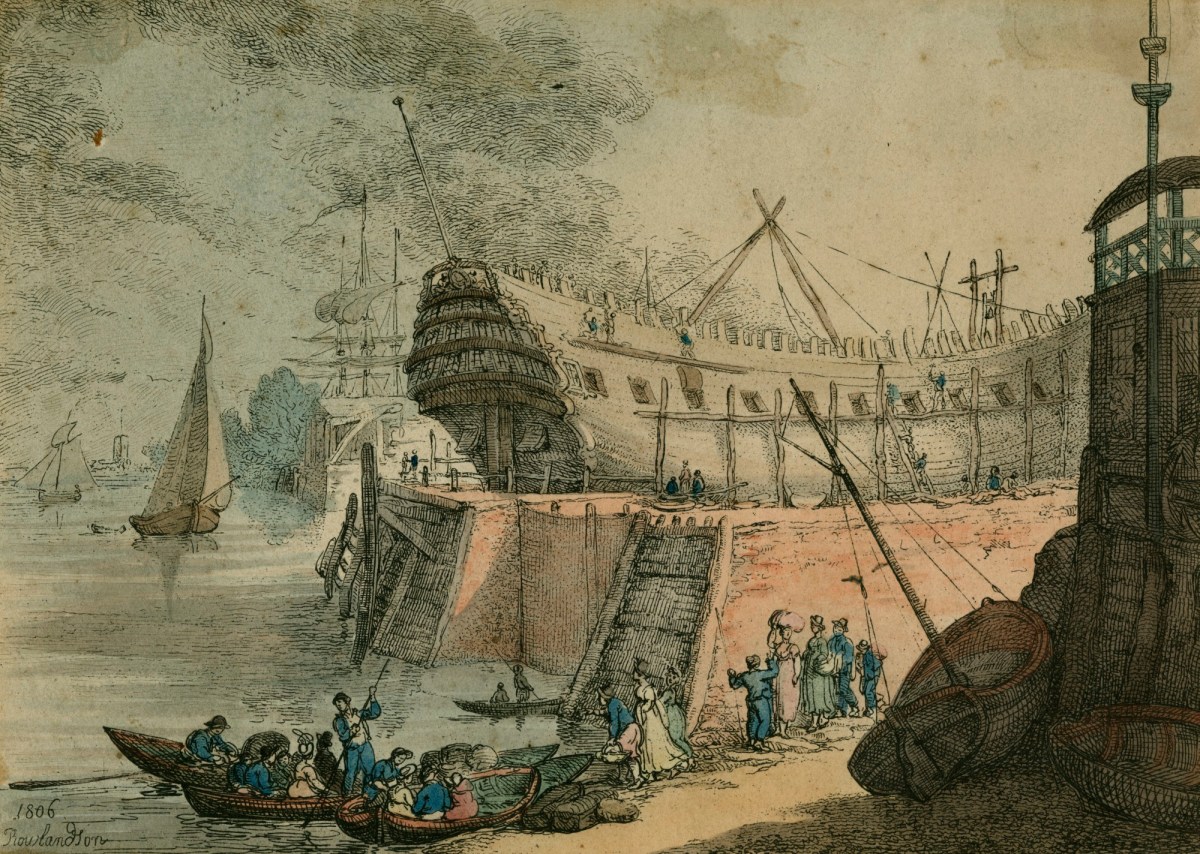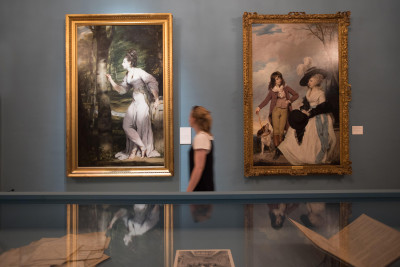
Thomas Rowlandson, Perry's Dock, Blackwall.
Hand-coloured etching. 164 mm. © Photo: Royal Academy of Arts, London.
This image is not available to download. To licence this image for commercial purposes, contact our Picture Library at picturelibrary@royalacademy.org.uk
Perry's Dock, Blackwall
Thomas Rowlandson (1757 - 1827)
RA Collection: Art
The etching shows a view of a dockyard from the sand with a large man-of-war ship in the background to the right and figures climbing in and out of small boats in the foreground. The work is signed and dated 1806 by Thomas Rowlandson. The sheet has been trimmed so any other possible details about where it is from are lost.
The British Museum owns the original drawing for the etching, which shows the same scene in reverse. The City of London owns an identical etching of the same size and states that it was published by Rudolph Ackermann (1764-1834); it is likely that this work was also published by Ackermann at the same time.
According to the City of London's catalogue entry for their etching, the view is of the Brunswick Dock, built in 1789-90 as part of the Blackwall Yard by the owner John Perry II, which in the early 1800s became part of the East India Docks. The history of the dockyard is charted in the Survey of London:
'During those years [the 1780s] the building of warships was as important for Blackwall Yard as was the construction of ships for the East India Company. During the 1780s John Perry II was at the height of his success. Order books were full, business was increasing, and he could contemplate the eighteenth-century's most ambitious private dock-building project on the Thames. This was the creation of the Brunswick Dock, a very large wet dock which was built in 1789-90 on marshland already owned by Perry to the east of the old yard ... the dock and associated structures were designed by the builder, engineer and surveyor John Powsey (b. c. 1734), who also supervised the construction work.'
The Huntington Collection owns a drawing, Blackwall, which is probably from around 1820 and is thought to be part of Rowlandson's 'Environs of London' series. The drawing is inscribed by Rowlandson with the following:
'Blackwall / in Middlesex between Poplar [?] and the mouth of / the river Lee is remarkable for the Ship yard & / wet dock of Jms [?] Perry Esq. The Dock, which / is the most considerable private one in Europe / contains with the water and embankments / near 19 acres. It can receive [?] 28 Large East / Indiamen & from 50 to 60 ships of smaller beam [?].'
There are three other studies of a similar-looking composition, two of which are entitled Launch of H.M.S. Nelson and dated 1805 and the third is entitled The Launching of H.M.S. 'Hibernia' at Devonport 1804 (Paul Mellon Collection). In the catalogue for the Paul Mellon Collection, John Baskett and Dudley Snelgrove state that Bernard Falk, in Thomas Rowlandson: His Life and Art, 'incorrectly described' his study as a launch of the HMS Nelson, as it is in fact the HMS Hibernia. They write:
'H.M.S. Hibernia, 120 guns, was built at Devonport in 1804 and launched under the direction of Joseph Tucker on 15 November of that year. She was the flagship to Admiral Lord Gardner in the blockade of Brest in 1805 and was commanded by Capt. C. M. Schomberg in the blockade of the Tagus in 1807. During her career, she flew the flags of Earl St Vincent, Sir Sydney Smith and Sir William Parker.'
As this etching is inscribed 'PERRY'S DOCK BLACKWALL', however, it is unlikely that it is the same ship as the HMS Hibernia was built in Devonport, Plymouth.
This work is one of several by Rowlandson that were in the collection of the artist Carel Weight RA, who bequeathed them to the Royal Academy.
Object details
164 mm
Start exploring the RA Collection
- Explore art works, paint-smeared palettes, scribbled letters and more...
- Artists and architects have run the RA for 250 years.
Our Collection is a record of them.



